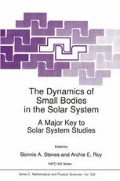Abstract
We discuss the efficiency of the implicit second-order integrator for an investigation of the nonconservative dynamics of particles around a star in a co-rotating coordinate system. A big advantage of this numerical integrator is its stability for conservative systems: the error of the semimajor axis and the eccentricity does not accumulate with an increasing number of the time steps. We tested this method for two dissipative systems: one including the Poynting-Robertson drag and the other including the PR-drag with a perturbing planet.
Access this chapter
Tax calculation will be finalised at checkout
Purchases are for personal use only
Preview
Unable to display preview. Download preview PDF.
References
Cordeiro, R.R., Gomes, R.S., Vieira Martins, R. (1997) A Mapping for Nonconservative Svstems, Celestial Mechanics and Dynamical Astronomy, 65, p.407
Gor’kavyi, N., Ozernoy, L., Mather, J., Taidakova, T. (1997) Quasi-Stationary States of Dust Flows Under Poynting-Robertson Drag: New Analytical And Numerical Solutions. Ap J. 488, Oct.10. p.268
Gor’kavyi, N.N., Taidakova, T.A. (1993) Theory of the Neptunian arcs. A multiconponent epiton and Galatea, Astronomy Lett., 19(2), p.142
Gor’kavyi, N.N., Taidakova, T.A. (1995a), Beta Pictoris and Numerical Study of the Giant Planets Hypothesis, in Circumstellar Dust Disks and Planet Formation, ed. R. Ferlet, A. Vidal-Madjar, Editions Frontieres, Gif sur Yvette Cedex — France, p.99
Gor’kavyi, N.N., Taidakova, T.A. (1995b) The Model for Formation of Jupiter, Saturn and Neptune Satelllte Systems. Astronomv Lett., 21(6), p.939
Potter, D. (1973) Computational Physics. John Wiley Ltd., London-New York-Sydney-Toronto.
Taidakova, T. (1990) The Numerical Analysis of the Dynamics of Particles About a Planet. I. Four-Body Problem. Nauch.Inform.Astrosoveta Akademii Nauk SSSR, Riga, Zinatne, 68, p.72
Taidakova, T. (1997) A New Stable Method for Long-Time Integration in an N-Body Problem, in Astronomical Data Analyses, Software and Systems VI, ASP Conf. Ser. 125, ed. G. Hunt & H.E. Payne, San Francisco: ASP, p. 174
Author information
Authors and Affiliations
Editor information
Editors and Affiliations
Rights and permissions
Copyright information
© 1999 Springer Science+Business Media Dordrecht
About this chapter
Cite this chapter
Taidakova, T.A., Gor’Kavyi, N.N. (1999). New Numerical Method for Non-Conservative Systems. In: Steves, B.A., Roy, A.E. (eds) The Dynamics of Small Bodies in the Solar System. NATO ASI Series, vol 522. Springer, Dordrecht. https://doi.org/10.1007/978-94-015-9221-5_39
Download citation
DOI: https://doi.org/10.1007/978-94-015-9221-5_39
Publisher Name: Springer, Dordrecht
Print ISBN: 978-90-481-5133-2
Online ISBN: 978-94-015-9221-5
eBook Packages: Springer Book Archive

